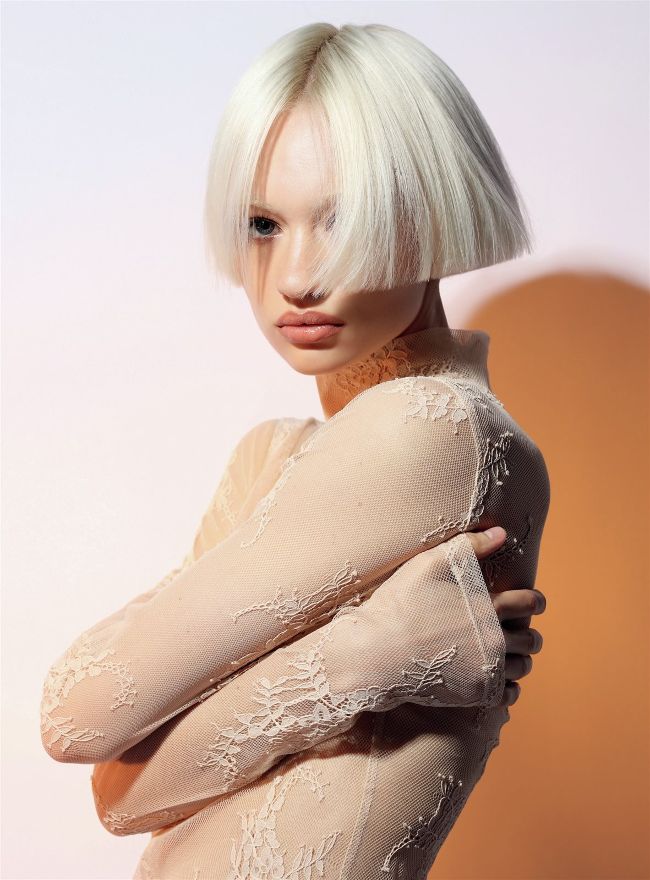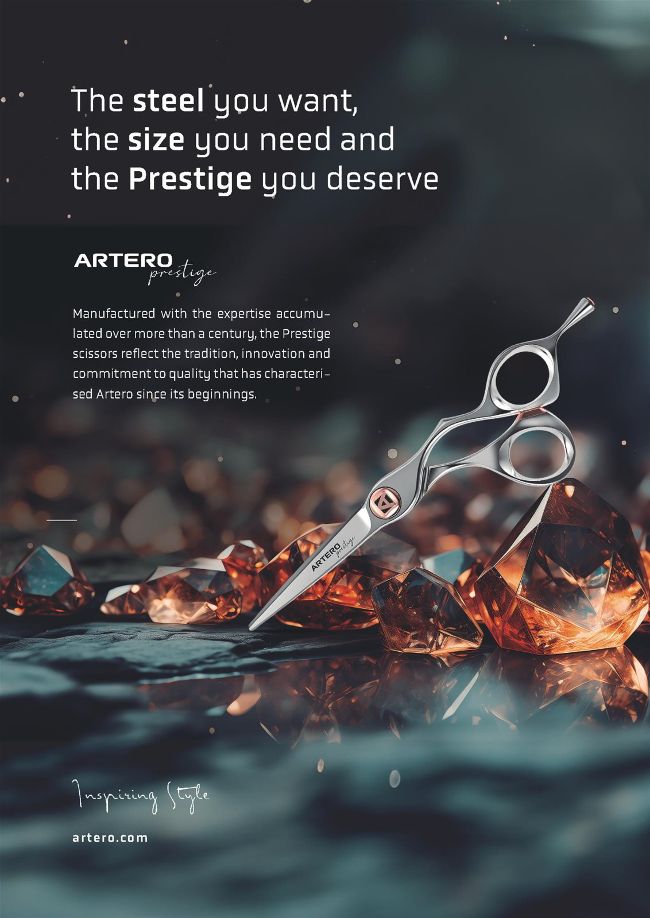SCISSORS
SHEAR GENIUS
Six stylists share their favourite scissors, and the looks they create with them

KAREN THOMSON
Your kitbag doesn’t have to be bursting at the seams for you to be an exceptional hairdresser, but it is crucial to have enough tools for the task at hand. From long to short blades, offset to symmetrical, we caught up with the masters of cutting to find out why different types of scissors deserve a spot in your selection and what’s currently available on the market.
“FOR ME SCISSORS ARE MORE THAN JUST CUTTING IMPLEMENTS, THEY'RE EXTENSIONS OF CREATIVITY.”
Sizing You Up
Scissors vary in size, with the most common models ranging from 5” and 7”. This refers to the length between the blade edge and the finger ring. Shorter scissors are often geared towards detailed work, while longer blades provide more power, making them ideal for bulk cutting. Elyse Pointon, stylist at Edward & Co and winner of Trend Image at the British Hairdressing Awards 2023, sponsored by Schwarzkopf Professional, agrees with this distinction, explaining: “I use a short blade as you can get a really sharp or soft finish depending on the look you are going for, and it can be used for adding texture, too.” Jake Unger from HOB Salons agrees, sharing: “I always use a smaller scissor – 5.5” and under – as this allows me to have more control over a line or a layer than a larger scissor.”

It’s not uncommon for hairdressers to store both long and short blade scissors in their kitbag. Philipp Haug, founder of Haug London Haus, explains: “I work with two pairs of Leaf scissors, I love that they plant 10 trees for every pair of scissors sold. I use the Black Edition 5.5” for bobs, graduations, hairlines, short fringes and detailed work, and on top of that, I use the Black Edition 7” for personalising, adding texture, deep point cutting and slicing.” In addition, Philipp also notes that a longer blade works particularly well when doing scissor-over-comb.
There are also other factors that can influence scissor selection, including comfort and familiarity. Like many stylists, Mark Hayes, International Creative Director at Sassoon, borrowed his first pair of scissors from a stylist he was assisting, and since then, has always used short-bladed scissors of approximately 5” in length. “I prefer a straight-handled model as they feel like an extension of my hands, whatever I want to achieve,” he tells us.

AYCAN KEMAL
Adam Smith, Art Director at Cobella Salon, also shares his preference, explaining: “I like a short-blade, bevelled-cutting scissor as I feel it offers greater control over the shapes I am wanting to create; ultimately providing a more precise cut.” In particular, he uses a bevelledcutting scissor when working on short hair and pixie cuts. For Adam this is a great choice for point cutting to enhance texture, as well as for blunt cutting and graduation. “Using a bevelled-cutting scissor encourages me to take smaller sections and carefully consider the outcome I am striving for,” Adam adds.
GUEST EDITOR, COS SAKKAS, SHARES: “SINCE STARTING AT TONI&GUY I HAVE ALWAYS USED THE BRAND’S B19 SCISSORS, AND IF YOU WANTED TO BE PART OF THE ARTISTIC TEAM, YOU HAD TO HAVE THESE. I’VE HAD THE SAME PAIR OF SCISSORS FOR MORE THAN TEN YEARS – SCISSORS SHOULD BE AN INVESTMENT AND IF YOU LOOK AFTER THEM THEY WILL LOOK AFTER YOU."
However, if you’re looking for something to tackle more bulk, Andrew Barton recommends a 6” scissor (his personal favourite is the Matakki 6” Vintage), which he says is great for clean, blunt cut lines.
Make it Your Own
Selecting your scissors is far from being a one-size-fits-all approach, it’s all about finding what works best for you. Mark chooses to exclusively use Japanese brands, and opts for a symmetrical handle as opposed to offset, adding: “I like to keep it simple.” He also removes the tang and scissor ring inserts, preferring scissors that have a feeling of weight to them.
Aside from making the tool your own, it’s also beneficial to think about how a pair of scissors can help you make a cut your own. “For me scissors are more than just cutting implements, they're extensions of creativity,” says Andrew. “All my Matakki scissors have offset handles. Their ergonomic design ensures a comfortable grip that prevents hand fatigue, even during my long days on set. This comfort allows me to maintain unwavering precision, while protecting my hand health, no matter how intricate the cut.” Jake agrees that precision is key, explaining: “I always choose a scissor that has a static blade, so I just move my thumb, which gives me more control over how I am cutting the hair.”
When it comes to making a cut your own, thinning scissors are a great selection says Adam: “I use thinning scissors for personalisation on shorter cuts to manage roots and introduce movement within the shape of the hair,” while Elyse shares: “They can also be used for taming bulk.”
As diverse as the styles they create, scissors offer a world of possibilities for every stylist, regardless of skill level, allowing them to tailor their toolkit and best serve their clients.

ELYSE POINTON